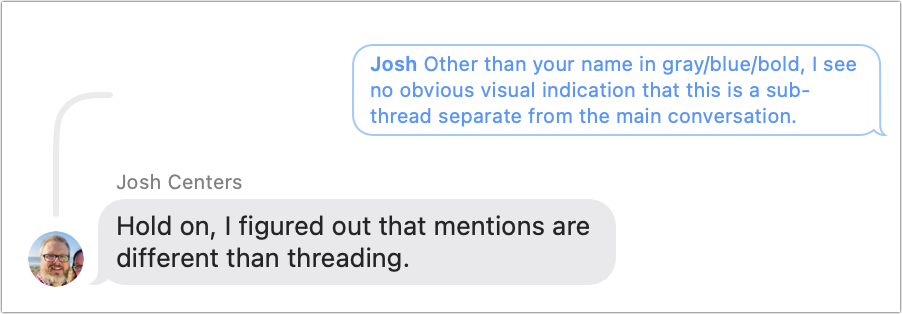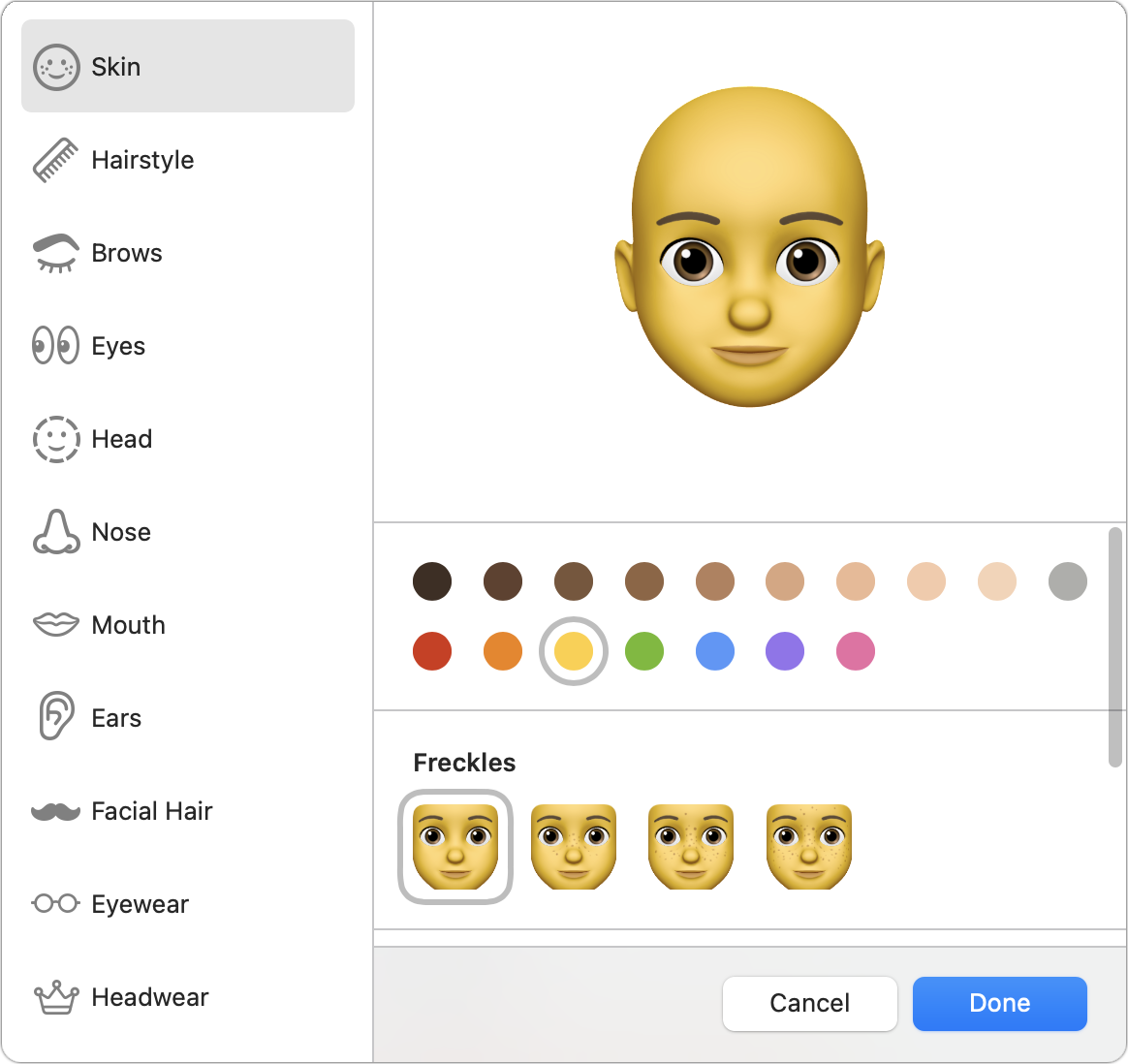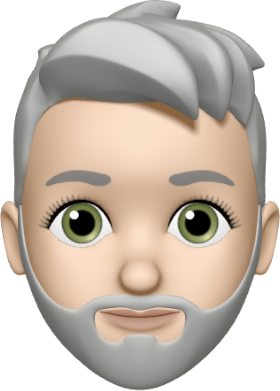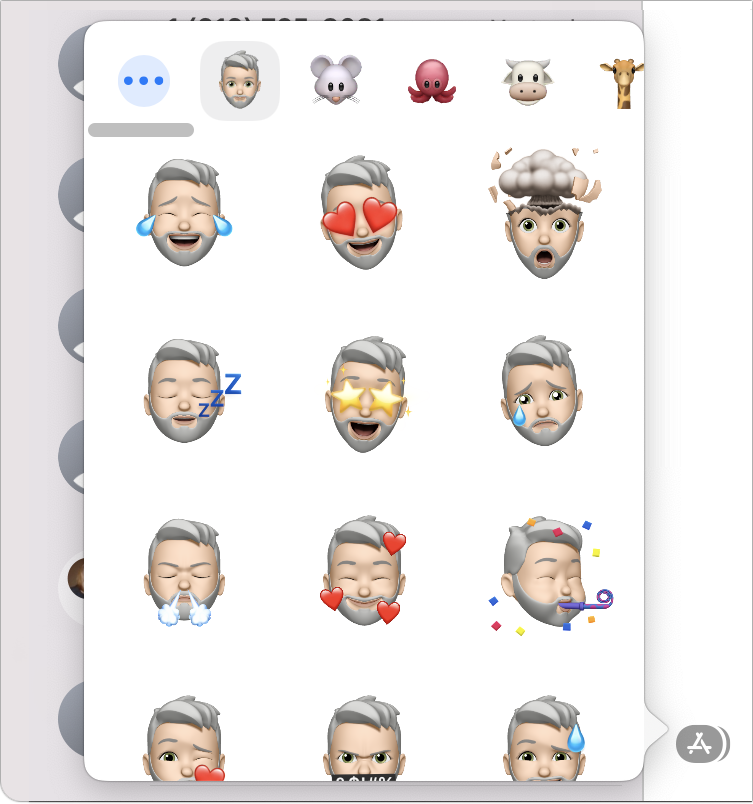Enhance Your Messages
Apple’s Messages app brings in some features that were previously present only in the iOS/iPadOS version of the app, and adds some new ones (which are also shared across platforms). Here’s a quick overview of what’s new.
Notice the Small Improvements
There are several small but interesting changes that are worth pointing out even though there’s not much to say about them:
Sidebar: One of the first things you may notice when opening Messages is that the sidebar, where your recent contacts are listed, may display only icons rather than names and message snippets. This is done to save space, but it’s unhelpful if most of your contacts don’t have photos or avatars. To restore the sidebar to full width, drag the vertical divider to the right. (Likewise, if you’re seeing a full-width sidebar and you want to shrink it, drag the divider toward the left.)
Pinned conversations: If you have lots of conversations and end up having to scroll or search frequently to find one you want to continue, you can now pin one or more of them at the top so they’re easier to find. To pin a conversation, right-click (or Control-click) it in the list and choose Pin from the contextual menu. You can pin up to nine conversations in this way.
Search: The search field now gives you more options. Click once in it to see recent correspondents, plus images and documents you’ve sent or received. Click one of these items to jump directly to the conversation in question. You can also, of course, type in the search field to see a list of messages matching your search text.
Share Name and Photo: A new preference (in Messages > Preferences > General), called Share Name and Photo, lets you automatically share your name and photo with other Apple users (that is, people using iMessage on their Apple devices, as opposed to SMS) when you start a conversation. With that selected, you can choose Contacts Only (to share automatically only with people in your Contacts list) or Always Ask (to be prompted to share with anyone). Deselect this to avoid sharing your name and photo.
Use the App Store Menu
In Messages for iOS and iPadOS, there has long been an App Store ![]() icon next to the field where you type the message text. Tapping this brings up a new row of icons, one of which takes you to the App Store where you can buy Messages add-ons such as games and stickers. That’s also what you tap to do unrelated things like access your photos and Apple Pay—but at least the App Store is one of the things that icon could lead to (as suggested subtly by the icon’s “stack” effect).
icon next to the field where you type the message text. Tapping this brings up a new row of icons, one of which takes you to the App Store where you can buy Messages add-ons such as games and stickers. That’s also what you tap to do unrelated things like access your photos and Apple Pay—but at least the App Store is one of the things that icon could lead to (as suggested subtly by the icon’s “stack” effect).
Well, in Big Sur, that icon has made the transition to the Mac, but weirdly the Mac App Store has no Messages add-ons, and you can’t access it at all from within Messages. Rather, this icon displays a pop-up menu with four useful, though unrelated, items:
Photos: Choose this to bring up a photo picker that gives you direct (and searchable) access to all your images from Photos. This makes it much easier than previously to include photos in your messages.
Memoji Stickers: Use stickers in your messages based on your own custom Memoji. There’s a lot more to say about this, so I address it separately in Use Memoji.
#images: Choose this command to display a searchable picker of reaction images (including animated GIFs) you can add to your message with just one click.
Message Effects: After typing some text, choose Message Effects to add garish, irritating animations (with sound effects) to your messages that will annoy your friends and confound your enemies. (I mean, do try these out, but let me just tell you from experience that they get old really fast.)
Improve Group Conversations
Three new features in Messages for Big Sur are aimed at making group conversations more manageable.
Add Group Photos
When you’re having a discussion with two or more people, you can assign a special photo to that group to make it easier to find in your sidebar. To do this, select the conversation and click the Info ![]() icon at the top of the window. Then click Change Group Name and Photo and enter an optional group name. Click the Photos
icon at the top of the window. Then click Change Group Name and Photo and enter an optional group name. Click the Photos ![]() button to select a photo or the Emoji
button to select a photo or the Emoji ![]() button to select an emoji; or select (or create) a Memoji from the list provided (see Use Memoji, below).
button to select an emoji; or select (or create) a Memoji from the list provided (see Use Memoji, below).
Call Out an Individual with a Mention
Sometimes in long threads with multiple people, not everyone is reading every message, and you want to be sure someone in particular notices a certain message (or that you notice specific messages from other people). You can accomplish either using a mention, which means adding a person’s name to your message in a special way.
To add a mention:
While composing a message, type the name of another person in the conversation. That name should turn gray.
Click the name to see that person’s name and avatar in a popover; then click the avatar. The name turns blue and bold.
Continue typing your message and press Return to send it.
What happens next for the other person (or for you, if someone has mentioned you) depends on each person’s preferences. In Messages > Preferences > General, if “Notify me when my name is mentioned” is selected (as it is by default), a mention results in a notification with the “message received” sound. If it’s deselected, the message is still sent and included in the conversation, but the recipient won’t be specially notified. Hiding alerts on a thread (by right-clicking the group and choosing Hide Alerts from the contextual menu) but leaving this selected—and telling your friends to be sure to mention you if they want to be sure you read something—is a good way to reduce all those constant dings on your Mac.
Reply Inline
Another thing that may happen within a group message thread is that you want to have a sub-conversation with one person in the group, without involving the group, but also without starting a separate thread. To do this, right-click (or Control-click) a message from that person within the group conversation and choose Reply from the contextual menu. All the other messages blur out, and your reply starts a separate thread (Figure 31) that only that other person will see, with a gray line and different styling so you can tell them apart.

Use Memoji
A Memoji is a cartoonish icon that’s supposed to be a representation of yourself, as you’d like to be seen by others on Messages. These have been around for some time on iOS and iPadOS, where I have completely ignored them because they don’t solve a problem for me. (Also, I’m not in the target demographic for this feature, which is to say I’m old and just don’t get it. Grumble grumble kids these days.) Anyway, in Big Sur, you, too, can create your own Memoji.
Create a Memoji
To create your own Memoji in Messages, choose Messages > Preferences > General and click the image at the top. Then, under Memoji, click the big plus  button. The first time you do this, an introductory window appears; if you see it, click Get Started. The Memoji editor (Figure 32) appears.
button. The first time you do this, an introductory window appears; if you see it, click Get Started. The Memoji editor (Figure 32) appears.

Go through each characteristic in the sidebar and select the skin tone, face shape, eye color, facial hair, and other aspects of your appearance—everything is pretty self-explanatory. When you have something you like, click Done.
Now you have a Memoji saved in Messages, which you can use in various ways—read on for more details.
My own attempt to create a Memoji yielded less-than-satisfactory results, I’m afraid (Figure 33), by which I mean nobody who knows me would pick that guy out of a police lineup. But then, the intention of Memoji is to be fun rather than accurate.

Use a Memoji As Your Avatar
Immediately after leaving the Memoji editor, you return to the image selector for your avatar. Your Memoji (and many other images, including cartoon animals) appears in the list under the Memoji heading. To make your new Memoji your avatar:
Click the heading to display versions of your Memoji with various facial expressions and angles.
When you see one you like, click it.
Click any of eight background colors to complete the look.
Click Done.
A dialog asks, “Use This Photo Everywhere?” Click Use to use it not only in Messages but also attach it to your Apple ID, which means it will show up in Contacts, Mail, and other locations that your friends and family may see. Or, to use it only in Messages, click Not Now.
Having done that, when you exchange messages with another Apple user in the Messages app (on any platform), they’ll see your Memoji.
Use Memoji Stickers
Stickers are images, often whimsical in nature, that you can send as part of a message (or even as a standalone message). When you create your Memoji, Messages automatically generates 36 different stickers based on that starting image.
To use a Memoji sticker:
Go to any conversation in Messages, or start a new one.
Click the App Store
 icon next to the message field and choose Memoji Stickers from the pop-up menu.
icon next to the message field and choose Memoji Stickers from the pop-up menu.Select your Memoji in the top row.
Scroll to find a sticker you like (Figure 34), and then click to insert it in the conversation.

Figure 34: Select a Memoji sticker here.
